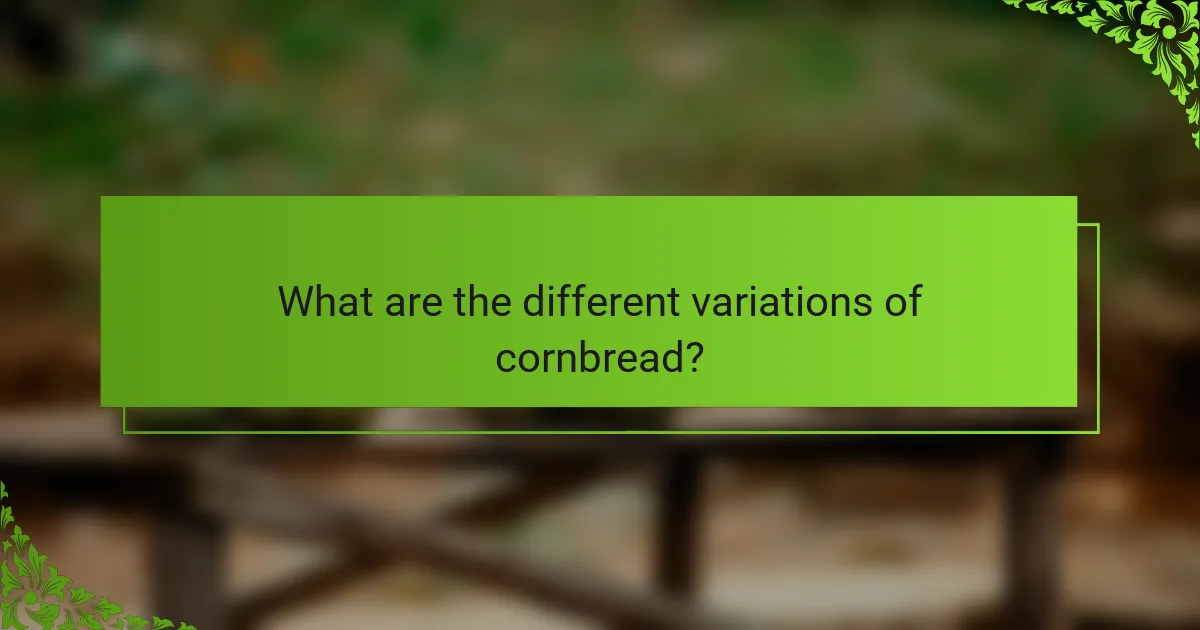Cornbread is a versatile baked good with various regional variations, each distinguished by unique characteristics. Southern cornbread is typically savory and tangy, while Northern cornbread is sweeter and more cake-like. Additional styles, such as Mexican cornbread and spoonbread, offer diverse flavors and textures. The article also highlights ideal pairings for cornbread, including chili, barbecue, and honey, which enhance its flavor profile. Tips for improving cornbread, such as using high-quality cornmeal and incorporating ingredients like jalapeños or buttermilk, are provided to elevate the overall experience.

What are the different variations of cornbread?
Cornbread has several variations, each with unique characteristics. Southern cornbread is typically savory and uses less sugar. It often includes buttermilk for a tangy flavor. Northern cornbread is sweeter and more cake-like, often incorporating sugar and eggs. Mexican cornbread includes ingredients like jalapeños and cheese for added flavor. Spoonbread is a moist, custard-like version that is baked in a dish and served with a spoon. Corn muffins are individual servings that are sweeter and often enjoyed as a snack. Each variation reflects regional preferences and ingredient availability.
How do sweet and savory cornbread differ in flavor profiles?
Sweet cornbread has a distinct sugary flavor profile, often enhanced with ingredients like honey or maple syrup. This sweetness creates a rich, dessert-like quality. In contrast, savory cornbread features flavors from ingredients such as cheese, jalapeños, or herbs. This results in a more complex, umami-driven taste. Sweet cornbread typically pairs well with butter and fruit preserves. Savory cornbread complements dishes like chili or stews. The sweetness in sweet cornbread balances well with spicy or tangy flavors. Savory cornbread can be enjoyed with a variety of savory toppings or as a side dish.
What ingredients are typically used in sweet cornbread recipes?
Sweet cornbread recipes typically use cornmeal, flour, sugar, baking powder, milk, eggs, and butter. Cornmeal provides the primary texture and flavor. All-purpose flour adds lightness to the batter. Sugar enhances sweetness, making it a dessert-like option. Baking powder serves as a leavening agent, ensuring the cornbread rises properly. Milk adds moisture and richness to the mixture. Eggs contribute to the structure and binding of the ingredients. Finally, butter adds flavor and a tender crumb. These ingredients combine to create a moist and sweet cornbread that is popular in various cuisines.
What ingredients are typically used in savory cornbread recipes?
Savory cornbread recipes typically use cornmeal, flour, baking powder, salt, milk, eggs, and butter. Additional ingredients may include cheese, jalapeños, herbs, or cooked bacon. Cornmeal serves as the primary base, providing texture and flavor. Flour adds structure to the bread. Baking powder acts as a leavening agent, ensuring the cornbread rises. Salt enhances the overall taste. Milk contributes moisture, while eggs bind the ingredients together. Butter adds richness and flavor. Cheese, jalapeños, and herbs can introduce unique flavors and textures, making the cornbread more savory.
What are the texture differences in cornbread variations?
Cornbread variations exhibit distinct texture differences based on their ingredients and preparation methods. Traditional cornbread is often crumbly and coarse due to the use of cornmeal. This texture is enhanced by the addition of buttermilk, which adds moisture and tenderness. Sweet cornbread tends to be softer and cake-like, often incorporating sugar and eggs, resulting in a lighter, fluffier texture. In contrast, savory cornbread may include ingredients like cheese or jalapeños, contributing to a denser and more substantial texture. Additionally, variations cooked in cast iron skillets develop a crispy crust, enhancing the overall mouthfeel. These texture differences are influenced by the balance of wet and dry ingredients, cooking time, and the type of cornmeal used.
How does the cooking method affect the texture of cornbread?
The cooking method significantly affects the texture of cornbread. Baking in a cast iron skillet creates a crispy crust and a moist interior. This is due to the skillet’s ability to retain heat and provide even cooking. Conversely, baking in a glass dish results in a softer crust and a denser texture. The glass retains less heat, leading to a different cooking dynamic. Steaming cornbread can yield a very tender texture, as the moisture prevents the formation of a crust. Each method alters the moisture content and heat distribution, impacting the final texture.
What role do ingredients play in achieving different textures in cornbread?
Ingredients significantly influence the texture of cornbread. The type of cornmeal used affects graininess and density. Coarse cornmeal yields a more rustic texture. Fine cornmeal produces a smoother, lighter cornbread. The ratio of liquid to dry ingredients determines moisture content. More liquid creates a softer, cake-like texture. Conversely, less liquid results in a denser, crumbly cornbread.
Fats, such as butter or oil, contribute to tenderness. They help create a moist crumb and prevent dryness. The addition of eggs enhances structure and richness. Eggs also aid in leavening, improving the overall texture. Sweeteners can impact texture as well. Sugar can create a softer, more cake-like cornbread, while less sugar can lead to a firmer texture.
Leavening agents, like baking powder or baking soda, introduce air bubbles. This process lightens the cornbread, making it fluffier. Each ingredient plays a crucial role in achieving the desired texture in cornbread.

What are the best pairings for cornbread?
The best pairings for cornbread include chili, barbecue, and honey. Chili complements cornbread with its savory flavors and hearty texture. Barbecue enhances the sweetness of cornbread, creating a balanced meal. Honey adds a sweet contrast, making it a delightful topping. Additionally, cornbread pairs well with greens, such as collard or mustard greens, providing a nutritious side. These pairings are popular in Southern cuisine, where cornbread is a staple.
How can cornbread be paired with grilled cheese?
Cornbread can be paired with grilled cheese by using it as a base or side. The sweetness of cornbread complements the savory flavor of grilled cheese. This combination enhances the overall taste experience. Additionally, cornbread can be sliced and used in place of traditional bread for the sandwich. The texture of cornbread adds a unique crunch when toasted. This pairing can be further enhanced with toppings like jalapeños or cheese varieties. These elements create a delicious contrast between sweet and savory. Many chefs recommend this pairing for its satisfying flavor profile.
What types of grilled cheese complement sweet cornbread?
Savory grilled cheese types complement sweet cornbread well. Options include sharp cheddar and caramelized onion. The sharpness of cheddar balances the sweetness of cornbread. Caramelized onion adds a rich, savory depth. Another option is pepper jack cheese with jalapeños. This provides a spicy contrast to the sweet cornbread. Additionally, goat cheese with herbs offers a tangy flavor that pairs nicely. These combinations enhance the overall taste experience.
What types of grilled cheese complement savory cornbread?
Cheddar and jalapeño grilled cheese complements savory cornbread well. The sharpness of cheddar enhances the cornbread’s flavor. Jalapeños add a spicy kick that balances the cornbread’s sweetness. Another good option is pepper jack grilled cheese. It offers a creamy texture with a hint of spice. A classic mozzarella and basil grilled cheese also pairs nicely. The mild flavor of mozzarella complements the cornbread without overpowering it. Each of these grilled cheese types enhances the overall taste experience.
What are some creative ways to serve cornbread with grilled cheese?
Serve cornbread with grilled cheese by creating a cornbread sandwich. Use two slices of cornbread in place of traditional bread. Fill it with your favorite cheese for a unique twist. Another option is to crumble cornbread on top of a grilled cheese for added texture. This enhances the crunch and flavor profile. Pair cornbread with a side of tomato soup for dipping. The combination is classic and comforting. Additionally, serve cornbread as a base for a grilled cheese melt. Top it with sautéed vegetables or meats. This adds savory elements that complement the cheese.
How can toppings enhance the cornbread and grilled cheese experience?
Toppings can significantly enhance the cornbread and grilled cheese experience by adding flavor and texture. For instance, toppings like jalapeños or cheese can introduce a spicy and creamy element. Sweet toppings such as honey or maple syrup can provide a contrasting sweetness to savory dishes. Additionally, toppings like crispy bacon or herbs can add crunch and freshness. The combination of these toppings can elevate the overall taste profile. Textural contrasts improve mouthfeel, making each bite more enjoyable. Studies show that diverse flavors and textures in food can increase overall satisfaction.

What tips can enhance your cornbread experience?
To enhance your cornbread experience, consider using high-quality cornmeal. Fresh, stone-ground cornmeal provides better flavor and texture. Experiment with adding ingredients like jalapeños for heat or cheese for richness. Incorporating buttermilk instead of regular milk can improve moisture and tanginess. Bake cornbread in a preheated cast-iron skillet for a crispy crust. Serve cornbread warm with butter or honey for added taste. Pair cornbread with savory dishes like chili or barbecue for a complementary flavor profile. These tips can elevate your cornbread to a more enjoyable level.
How can you choose the right cornbread for your meal?
To choose the right cornbread for your meal, consider the flavor profile that complements your dish. Sweet cornbread pairs well with spicy or savory foods, enhancing their flavors. Savory cornbread works well with soups and stews, providing a hearty complement.
Next, evaluate the texture of the cornbread. If you prefer a moist and crumbly texture, opt for recipes with added ingredients like buttermilk or creamed corn. For a denser option, choose cornbread made with a higher cornmeal ratio.
Finally, think about the meal’s overall theme. Southern-style meals typically benefit from traditional cornbread, while more contemporary dishes might be enhanced by gourmet variations. These considerations ensure that your choice of cornbread elevates your meal experience.
What factors should you consider when selecting cornbread variations?
When selecting cornbread variations, consider flavor profile, texture, and ingredient preferences. Flavor profile includes sweet versus savory options. Sweet cornbread often contains sugar or honey, while savory varieties may include cheese or jalapeños. Texture impacts the eating experience; some prefer a crumbly cornbread, while others like a moist, dense version. Ingredient preferences involve dietary restrictions, such as gluten-free options or the inclusion of whole grains. Additionally, consider the pairing with dishes like grilled cheese, as some cornbread complements flavors better than others. These factors ensure the chosen cornbread variation meets personal taste and culinary needs.
How can you modify cornbread recipes to suit your taste preferences?
You can modify cornbread recipes by adjusting ingredients to enhance flavor. For sweetness, add sugar or honey to the batter. For a savory twist, incorporate cheese, jalapeños, or herbs. Changing the type of cornmeal can affect texture; use fine cornmeal for a smoother cornbread. Experimenting with liquid can also alter the outcome; substitute milk with buttermilk for richness. Adding fruits like blueberries or corn kernels can introduce additional flavor. Altering baking time and temperature can create a crustier exterior or softer interior. Each modification can cater to personal taste preferences, resulting in a unique cornbread experience.
Cornbread is a versatile dish with various regional variations, including Southern, Northern, Mexican, and spoonbread, each characterized by distinct flavors and textures. This article explores the differences between sweet and savory cornbread, detailing their unique ingredient profiles and cooking methods that influence texture. Additionally, it discusses optimal pairings for cornbread, particularly with grilled cheese, and offers tips for enhancing the overall cornbread experience. Readers will gain insights into modifying recipes to suit personal preferences and selecting the right type of cornbread for different meals.